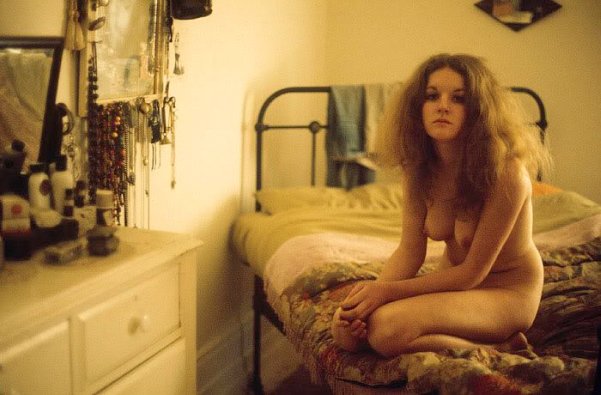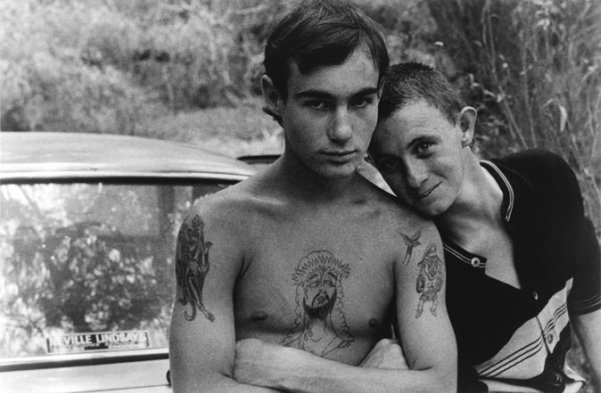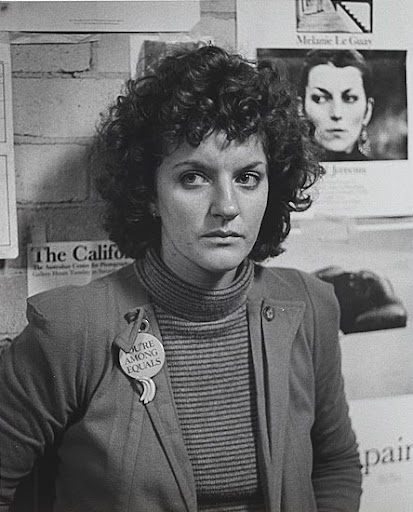
Iconic images that define a country have always fascinated me, and Vale Street, along with other photographs and self-portraits by Carol Jerrems perfectly capture an Australia of the 1970's long forgotten by time. You can practically hear Madder Lake playing in the background when viewing her work. And this excellent documentary chronicling the life and untimely death of the artist puts the viewer dead center into an Australian culture that was as vibrant as anything that was happening in either Europe or the States during the same period.
Included in this post is a short film featurette by Jerrems that was included in the DVD. We've also added it to the download. Enjoy.
From Peter Wilmoth at The Age:
It was when Carol Jerrems was making a film about a gang of 15-year-old sharpie boys from Heidelberg, most of whom had been expelled from school and, in their own words were involved in "bashing, beer, sheilas, gang bangs - which is rape - gang fights, billiards, stealing and hanging out" that she found out most clearly the cost of getting involved with her subjects.
"So far I have myself only narrowly escaped rape but was bashed over the head by the main actor while driving my car, which had just been dented by the rival gang with sticks. They steal my money and cigarettes when I'm not looking, but I refuse to be deterred."
Very little deterred Jerrems, even the game in which the sharpie boys drew straws to see who would "go off" with her. Her shy, earnest demeanor and angelic face framed by golden frizz belied a ferocious appetite for photographs that would capture the moment, a thirst for the next great shot that could - and sometimes did - endanger her life.
Friend Michael Edols recalls in a new film about her life that he and Jerrems went into a pub in Sydney's Redfern. "I remember watching Carol in the middle of this room and she turned her camera on this young man and photographed him." The man grabbed at Jerrems and tore off her necklace while Edols dragged her out of the pub and into the car. "On the way out," Edols says, "I got whacked in the chest and cracked two ribs. We had every window of the car totally smashed in, including the headlights."

"Carol was very shy and she didn't like being shy and she was always pushing against her inhibitions and her limits, and that often led her to dangerous situations," says Kathy Drayton, the director of Girl In A Mirror, about this extraordinary photographer's intense, short life. "There was a certain amount of naivety.
"Her photographs engage the viewer in an intimate relationship with her subjects. It's not always a friendly intimacy - sometimes her subjects look defensive, irritated or even menacing, but you always sense that you're seeing beyond the mask into the soul."
Jerrems was born in Melbourne in 1949, grew up in middle-class Ivanhoe and studied photography at Prahran College between 1967-70, where she was filmmaker and photography teacher Paul Cox's best student. "She stood out, she was odd," Cox says in the film. "She had this odd little smile."
Jerrems had found her calling early. In her second year at college, her confidence was such that she made up a stamp, "Carol Jerrems, Photographic Artist" which she would stamp on all her finished prints. "We were a bit scared of Carol," former Daddy Cool guitarist Ross Hannaford, who was also at Prahran, says in the film. "She was real serious. Carol was the first feminist I ever met. I remember she gave me a lift home once. I said 'Thanks, baby'. She said 'Come here. You don't call me baby.' Got a bit of a lecture."

Jerrems' success came quickly. In 1972, Rennie Ellis, the Melbourne photographer who died in 2003, opened Australia's first dedicated photographic gallery, Brummels, in South Yarra and selected the 23-year-old Jerrems' work as part of its first exhibition, a show called Erotica.
Always carrying a camera and flirting with the idea of danger, Jerrems wanted to capture the raw edges of the world she saw around her, subjects others weren't focusing on artistically: sharpie subculture, street life and urban indigenous people. "People were stereotyping indigenous people," said a friend, Ron Johnson. "I think Carol was showing 'This is not what it's all about, look, look at the expressions on people's faces - see what they're really feeling."
"People at the time were interested in traditional Aboriginal people while Carol was solely interested in urban Aboriginal people," says Kathy Drayton. "And at the time, sharpies were considered to be real bogans so it was unusual for someone of Carol's background to be interested in them."
Jerrems found work teaching photography at Heidelberg College, in the middle of a tough housing commission area. She was fascinated by the anti-social wildness of the boys, and spent time photographing them swimming in rivers, hanging around in backyards, wearing their skinned-rabbit jumpers, tight jeans and short curtains of fluffy dyed hair.
In this milieu, Jerrems found what Drayton calls the "brash sexuality of Australian youth in the '70s, a sexuality laced with vulnerability and darkness", and it inspired her most famous photograph. Vale Street 1975 is a mesmerising portrait of Melbourne model Catriona Brown flanked by two sharpie teenagers, the boys standing just behind in the shadows. The shot was taken at a house in Vale Street, St Kilda, at the end of a long day of shooting. Brown had asked Jerrems to take a shot for her folio, and Jerrems agreed, as long as she could shoot the boys with her, and use the shot for her folio.
The photograph is, says Drayton, regarded as a significant moment in Australian photography "as it bridges documentary realism and the more subjective style of photography that marks the post-modern era". The power of the photograph was the human connection. "Jerrems does not presume that she is outside the event without influence on it," wrote Helen Ennis, former curator of photography at the National Gallery of Australia.
Jerrems' development as a portrait photographer coincided with rising interest in photography as an art form in Australia. Photographers were beginning to be deeply involved with their subjects rather than discreet observers shooting at a distance. Jerrems saw the traditional documentary style of photography as exploitative and believed the more personal collaborations between photographer and subject to be more honest, even if they were more risky personally.
Paul Cox once wrote: "She had to experience everything and feel things deeply before she could record them. She lived to the fullest, then withdrew into her own world."
Part of the power of Jerrems' work stems from its reflection of a certain pocket of life in the mid to late 1970s, the world of filmmakers, photographers and other creative types living in group houses. The sexual freedom and youthful confidence of the time, as enunciated and encapsulated by Skyhooks' Living In The Seventies album, is everywhere in her work. Drayton says Jerrems was "adventurous and forthright in her sexuality", having affairs with many of her friends, men and women, reflected in her work, "at times seductive, at others, frankly post-coital".
In the film, one of her great loves, the filmmaker Esben Storm, remembers Jerrems arriving in Sydney with new photographs. "Inevitably they'd be photographs of her waking up . . . with someone. While I'd been off sort of having wild times, she'd be having her wild times. She would sleep with someone and that would mean there would be an intimacy that would allow her to take photographs.
"It was the time of free love in a way, even though we weren't that free. There were ideals that it was uncool to be jealous and that you weren't possessive. We all tried to live by that, even though we couldn't really."
Greg Macainsh, Skyhooks' songwriter, remembers Jerrems photographing the band for a book called Million Dollar Riff. "She came to a number of gigs," he says now. "She was very quiet, reserved. She would make herself virtually invisible. I remember her in the dressing room being very still in the corner. She didn't take a lot of shots, she would wait for the right moment. She wasn't a motor-drive type, she was a bit like a sniper, waiting for the perfect opportunity."
Ross Hannaford was close to Jerrems for a while at Prahran College and remembers the seriousness with which she pursued her photography. "It was a time when there was incredible optimism in the air," he says now. "If you had a dream, you could do it. There didn't seem to be anything holding people back. I'd watch Carol shooting and I didn't realise what she was up to. 'What are you taking all that rubbish for?' But when you look back it seemed to encapsulate the times and the life around you. Her work took on a significance later on."
But amid the gaiety and youthful charge in Jerrems' pictures, Helen Ennis says a distinct change in mood is evident in the work. "The early photos between 1972 and 1975 were all about optimism. There's a huge amount of energy in them. It was all bound up with the excitement about the Whitlam government and this desire for change. But from 1976 I don't think they were anywhere near as optimistic."

Darkness
It wasn't just the Whitlam dream fading that gave Jerrems' work this darkness, nor the mood captured in the Skyhooks song Whatever Happened To The Revolution? ("We all got stoned and it drifted away"). While there is great exuberance in the decade the film documents, there is also a profound sadness about Jerrems' life. The odd little smile that Paul Cox talks about is rarely seen in the several self-portraits that feature in the film. Instead, there are many hints of the depression that she struggled with. Her friend Robert Ashton, who lived with Jerrems in a group house, remembers her bedroom door being closed for hours and even days.
In 1979, Jerrems went to Hobart to teach. Shortly after arriving she was diagnosed with polycythemia, a rare blood-related cancer. She underwent months of invasive and painful procedures, but came to a realisation she was dying. Jerrems photographed and wrote about her physical decline. She photographed doctors hovering, the scars on her stomach, and her mother, with whom she had a difficult relationship, visiting. As the camera pauses on a shot of her mother, an actress reads from Jerrems' journal: "She is one of the few people with the ability to push me over the edge into tears or screaming."
Carol Jerrems died in Melbourne in February 1980, three weeks before her 31st birthday. Her work was bequeathed by her mother to the National Gallery of Australia. In 1990 a retrospective was staged, but until now Jerrems has remained unknown outside photographic and film circles.
Girl In A Mirror gives an insight into the counterculture of the 1970s - the music, the cars, the fashions, the social tensions, the sexual experimentation. Kathy Drayton, with help from the National Gallery of Australia, had access to hundreds of Jerrems' photos as well as shots from Rennie Ellis (who photographed Jerrems often), friend Robert Ashton and Henry Talbot. The journals Jerrems kept after 1975 are used to "narrate" the film.
Drayton, who has worked as an editor with SBS television as well as editing a variety of independent experimental films and short dramas, says her interest in Jerrems was piqued when she saw three of her photographs at a New South Wales Art Gallery exhibition. The "deceptively simple power and beauty" of the three photos haunted her, and she began to research Jerrems.
"There's an emotional intensity and intimacy with Carol's photographs," she says.
Who was Carol Jerrems? "There were a huge number of perspectives from people about Carol," says Drayton. "She went into roles with people, played games. She became whatever people wanted her to become."
Technical Information:
Title: Girl in a Mirror: a Portrait of Carol Jerrems
Year: 2005
Country: Australia
Director: Kathy Drayton
Source: DVD Retail
Video Codec: XviD
Container: .mp4
Size: 568 MB
Length: 0:55:31
Programs used: Unknown
Resolution: 640x368
Aspect Ratio: 16:9
Video: MPEG4 @ ~2500 kb/s
Frame Rate: 25 fps
Audio: English- AAC Stereo @ 127 kb/s
Subtitles: None
Bonus: Hanging About (a short film by Carol Jerrems)

Girl in a Mirror Megaupload Link


